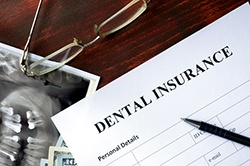Tooth Extractions – Weyauwega, WI
Restoring a Happy, Healthy Smile
Dr. Twohig prioritizes saving his patients' natural teeth whenever possible, recognizing that no replacement matches the quality of a natural tooth. However, in cases where a tooth poses potential future oral health complications and no other restorative measures suffice, extraction may be necessary. Our team is committed to ensuring your comfort and the success of your treatment. If you're experiencing tooth-related issues, don't hesitate to reach out for an appointment. We'll discuss your options, including tooth extractions, and tailor a plan to meet your needs.
Reasons Why Tooth Extractions Are Necessary

Tooth extractions are typically considered the last resort in treatment decisions. However, there are many situations where extracting a tooth is the ideal option. Some scenarios in which that occurs include:
- Advanced decay, causing significant deterioration of the tooth
- Extensive gum disease compromising the tooth's stability
- Severely cracked or broken teeth
- Creating space for orthodontic treatment
- Severe oral infections
- Risk of nearby teeth becoming damaged
The Process of Removing a Tooth

Once we've conducted a comprehensive examination and have confirmed there are no other ways to salvage your tooth, we'll start planning how to remove it. First, we'll numb the area around your tooth to ensure you won't feel any pain during the procedure. Then, the extraction process can commence.
There are two types of extractions: simple and surgical. Simple extractions are when the tooth is easily visible, and surgical ones are when the tooth is hidden under the gums or other teeth. For more complex cases, we may need to make a small incision to reach the tooth better.
Once we can see the tooth clearly, we'll use a dental elevator to gently wiggle it out. When it's loose enough, we'll remove it efficiently with dental forceps.
Tooth Extraction Aftercare

Before your tooth is extracted, we'll provide detailed instructions on what to do afterward to help you heal smoothly. Here are some tips to follow:
- Stick to soft foods to avoid getting food stuck in the extraction site.
- Take any prescribed medications exactly as instructed, whether it's antibiotics or pain relief.
- Avoid using a straw, as sucking could dislodge the blood clot and cause dry socket.
- Steer clear of strenuous activities for a couple of days to prevent bleeding and discomfort.
- To reduce swelling, apply a cold compress to your cheek for 10 minutes at a time, with breaks in between.
- Rest up and keep your head elevated slightly to prevent blood clots.
- Keep the extraction area clean by rinsing your mouth gently with a saltwater solution four times a day. Be careful not to spit forcefully; instead, let the solution dribble out naturally into the sink.
Understanding the Cost of Tooth Extractions

If you have an upcoming tooth extraction in Weyauwega, you may have questions about the potential cost. Well, due to variables like the tooth's location and your insurance coverage, there's no fixed price. During your consultation with Dr. Twohig, we'll assess your specific circumstances and provide you with a personalized estimate. Don’t worry – taking the steps to care for your smile by extracting the problematic tooth may be more affordable than you think! Click on the button below to learn more.
Factors That Can Affect Tooth Extraction Cost

The cost of a tooth extraction will vary from patient to patient, which is why it’s impossible to provide an estimate until we've examined your mouth. After your initial appointment, we'll have a clearer picture of the factors influencing the overall price, including:
- The size and shape of the tooth requiring removal
- The tooth's location in your mouth
- The number of teeth needing extraction
Additionally, it's important to consider the cost of tooth replacement post-extraction. Even if the gap is not visible, restoring your smile is necessary for several reasons. For instance, untreated tooth loss can lead to dental shifting, resulting in bite issues and an increased risk of oral health problems.
Does Dental Insurance Cover Tooth Extractions?

Dental insurance coverage is typically split up into different tiers of services. A tooth extraction is often classified as a major restoration or procedure, which means it can receive around 50% coverage. However, it's important to understand that your plan might have specific limitations on the number of teeth covered for extraction within a certain timeframe. Plus, your benefits only activate once you've met your deductible and before you've reached your annual maximum.
Since every dental insurance policy is unique, you should review your plan details or contact your insurance provider for a better understanding of your coverage. Additionally, our knowledgeable front desk staff is available to assist you in maximizing your benefits.
Other Options for Making Tooth Extractions Affordable

Dental insurance isn't your only option for affordable tooth extractions. If you’re uninsured, we can help you apply for CareCredit financing! This flexible financing option allows you to spread the cost of your treatment into monthly installments over an extended period, with many plans offering low to zero interest rates.
Tooth Extraction FAQs
Does Getting a Tooth Extraction Hurt?
Many patients worry about pain during dental procedures, including tooth extractions. Fortunately, the first step in the process is numbing your mouth, which significantly minimizes discomfort during the extraction itself. While some soreness and discomfort are normal afterward, following your aftercare instructions carefully is crucial. This helps prevent infection, reduce swelling, and promote healing. If your pain intensifies or you show signs of infection (i.e., fever), contact our office immediately.
Can I Leave the Space Empty After a Tooth Extraction?
While it might seem unnecessary to replace a back tooth that isn’t visible, your teeth play a crucial role beyond creating a beautiful smile. They are essential for proper chewing and clear speech. Missing even one back tooth can make chewing difficult, potentially leading to poor nutrition and indigestion.
Additionally, a missing front tooth can affect your ability to enunciate clearly, possibly causing a lisp. That’s why it’s recommended to schedule an appointment with our team to explore tooth replacement options once you have healed.
What Can I Do to Speed Up the Healing Time?
To speed up the healing process after a tooth extraction, you need to prioritize rest. Avoid exercise and strenuous activities for at least 24 hours, and keep your head elevated. Follow Dr. Twohig’s instructions for keeping the gauze in place to help the blood clot form. Do not touch the wound with your tongue or hands.
Steer clear of irritants like mouthwash and acidic foods. You can also prevent dry socket by staying hydrated, avoiding straws, and not spitting. Use an ice pack or cold compress on your cheek to reduce swelling. Lastly, only take pain medication recommended by Dr. Twohig as certain medications (like aspirin) can slow down clotting and delay healing.
What Risks Are Involved with Tooth Extractions?
Tooth extractions are generally very safe, but like any dental procedure, they come with some risks. The primary risk is infection, which can spread throughout the body if not addressed promptly. Another significant risk is dry socket, a painful condition that can delay recovery. To mitigate these risks, Dr. Twohig will provide detailed aftercare instructions and inform you of common symptoms of infection to watch for. Following these guidelines carefully will help ensure a smooth and safe healing process.
